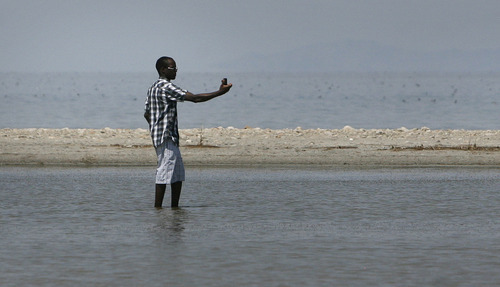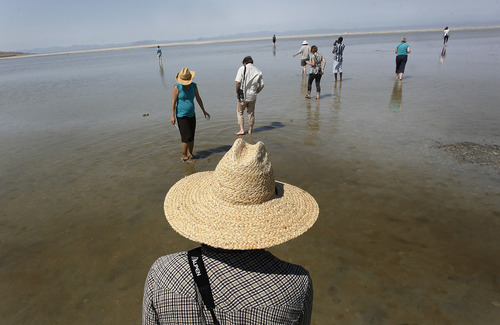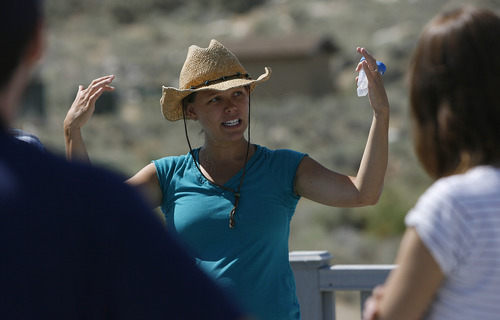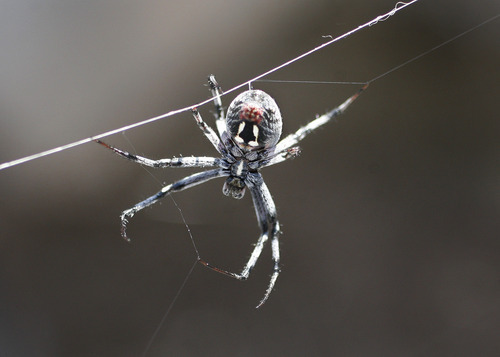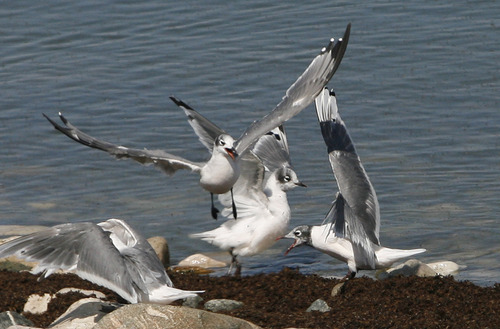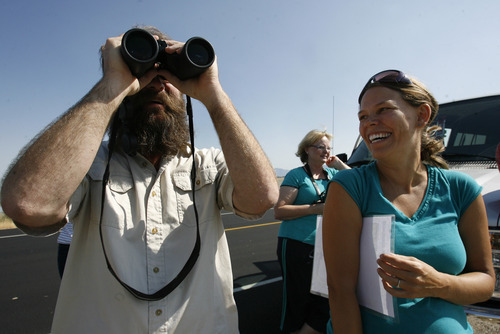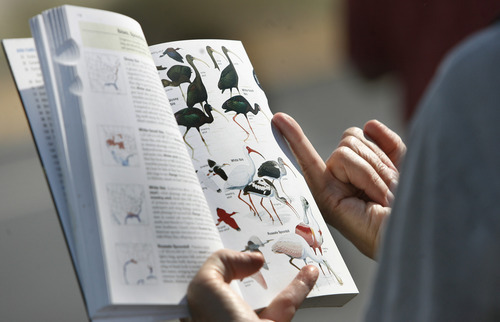This is an archived article that was published on sltrib.com in 2012, and information in the article may be outdated. It is provided only for personal research purposes and may not be reprinted.
As a young man growing up in Uganda, Titus Elanyu would see birds in the wildlands of that equatorial African country, but not the dizzying diversity of avian species found at the Great Salt Lake.
To see as many different birds as he could on the huge saline lake, Elanyu would have had to visit a zoo.
"I wanted to see the beautiful bird species that come in big numbers here," Elanyu, 22, a political science and government studies student at Utah Valley University, said Saturday. Since arriving at UVU last semester, Elanyu's new student friends kept talking up Great Salt Lake as a place he must visit as soon as possible.
And after several stops along the causeway between Syracuse and Antelope Island to hear Great Salt Lake Institute biologist Jaimi Butler point out a blizzard of birds feeding, swimming and walking the shores of Farmington and Gilbert bays, Elanyu pronounced himself pleased that he had come on a tour organized by Utah Interfaith Power and Light.
"This is amazing," Elanyu said, though he admitted he wasn't prepared for the smell his friends talked about. "It stinks."
The lake's signature smell was hardly in full bloom, though under a flawless sky with the sun beating down on the playas that stretched hundreds of yards, the odor was unavoidable.
Butler, a fisheries biologist and coordinator of the institute housed at Westminster College, says the odor, like the lake, is an acquired taste. When someone notices it, she likes to say the smell doesn't stink; it smells like biology.
And to others who badmouth the body of water because of the heat, saline content, brine shrimp and brine flies, Butler concedes it's also an acquired taste.
"It's very different," she acknowledged. "It makes me itchy when I get into it. It may smell a little. It's like coffee. When I first tried it, I didn't like it, and now I can't live without it. The same goes for the lake. I can't imagine not being here."
Utah Interfaith Power and Light asked Butler to lead the tour because the group hopes religious people will forge links between their faith and the organisms that inhabit seemingly unspoiled places like Great Salt Lake, member Jason Brown said.
"It's connecting faith with ecology. Most people don't know how to talk about ecology in spiritual terms,"said Brown, who called himself a "post-Mormon," a respecter of the religion but whose ideas about spirituality have moved beyond its doctrines.
With Butler as a guide, the nuances of the lake began to emerge. Huge orb weaver spiders clinging to silk webs, their bodies full of mercury that probably originated in the smelters of gold refineries and the stacks of coal-fired power plants. Butler wonders what happens when the spiders are picked up by birds who feed them to their chicks.
"There are some ways that the lake heals itself," she said, pointing out that heavy concentrations of selenium in the lake appear to cancel out the toxic effects of mercury. "But should we count on that? I don't think we should. This is a bird mecca."
In another part of the lake, long-billed curlews strut along the shoreline, eating brine flies with the ease of someone comfortable with chopsticks. Wilson's Phalaropes swim in circles, creating sucks that pull shrimp off the lake's bottom and into their waiting mouths. Tiny brine shrimp bear live young. Flies fly thick as clouds through which birds run and gobble them down.
Even the sand at Bridger Bay on the island's northwest side is odd. Instead of grains of mineral fragments washed down from eroding rocks, this sand is formed in the lake. Each grain is composed of layers of calcium carbonate deposited around a tiny brine shrimp fecal pellet.
"I love this place," said Eva Bergius, an art teacher from Layton who hails from Sweden and came to Utah more than a decade ago from Germany.
"I'm interested. I want to know why it smells like it does. I want to know why it looks like it does. I want to compare it to the European oceans that I know best."
Asked what she would take away from the tour, Bergius, 60, said she would remember the intangible qualities of the lake and island.
"The air that I breathe, and all of the blue," she said pointing to the sky and distant mountains to the west. "But most of all, the peace."


